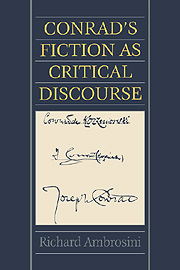Book contents
- Frontmatter
- Contents
- Acknowledgments
- List of abbreviations
- Introduction
- 1 The critical discourse: five tropes
- 2 Working on language and structure: alternative strategies in The Nigger of the “Narcissus” “Karain” and “Youth”
- 3 The mirror effect in “Heart of Darkness”
- 4 Lord Jim (I): the narrator as interpreter
- 5 Lord Jim (II): the narrator as reader
- Postscript
- Notes
- Bibliography
- Index
4 - Lord Jim (I): the narrator as interpreter
Published online by Cambridge University Press: 05 January 2012
- Frontmatter
- Contents
- Acknowledgments
- List of abbreviations
- Introduction
- 1 The critical discourse: five tropes
- 2 Working on language and structure: alternative strategies in The Nigger of the “Narcissus” “Karain” and “Youth”
- 3 The mirror effect in “Heart of Darkness”
- 4 Lord Jim (I): the narrator as interpreter
- 5 Lord Jim (II): the narrator as reader
- Postscript
- Notes
- Bibliography
- Index
Summary
In his Author's Note to Lord Jim, Conrad claims that his “first thought was of a short story, concerned only with the pilgrim ship episode; nothing more” (LJ, viii). After a few pages, however, he dropped the subject and forgot all about the story. Only later, he continues, did he realize that the Patna episode “was a good starting-point for a free and wandering tale; that it was an event, too, which could conceivably colour the whole ‘sentiment of existence’ in a simple and sensitive character.” Those first pages provided the subject for Lord Jim, but “the whole was deliberately rewritten.” Eloise Knapp Hay has taken Conrad's claim literally, and has suggested different reasons as to why Conrad extended beyond Marlow's inquiry the story based on the Jeddah case. There is, however, enough evidence that Patusan was part of the original story. Alexander Janta, in his examination of the first sketch of the novel, notes that while Conrad “wrote the title of his intended story Jim: A Sketch and underlined it with one bold stroke … he already had an awareness of the entire scope of the two part story, comprising both the Patna episode and its consequence – Patusan.” The transformation of the first sketch is not the outcome of a change in the tale's subject.
- Type
- Chapter
- Information
- Conrad's Fiction as Critical Discourse , pp. 100 - 141Publisher: Cambridge University PressPrint publication year: 1991



